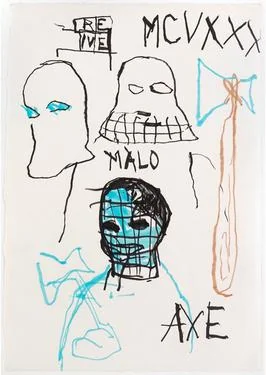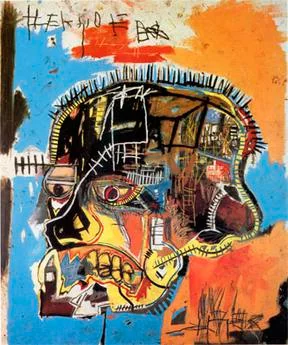Institutional endorsement can skyrocket an artist’s fame and market value, as seen with Jean-Michel Basquiat. However, this selective system often overlooks many talented artists, creating disparities in the art world. It underscores the complex interplay between artistic recognition and market forces.
A real-life example of how institutional endorsement can enhance an artwork’s or artist’s reputation is the case of Jean-Michel Basquiat. Before his work was featured in prestigious institutions, Basquiat was a relatively unknown street artist in New York. However, after his work was showcased in the 1981 exhibition “New York/New Wave” at PS1 (now MoMA PS1), a respected contemporary art institution, his career took a significant turn.

In his brief yet impactful career, Basquiat created around 1,500 drawings, 600 paintings, and numerous sculptures and mixed media pieces. He often drew on available objects, using various media like ink, pencil, and oil-stick. His work included cartoon-inspired drawings and sometimes featured Xerox copies of his drawings pasted onto larger canvases.
This exhibition was pivotal in bringing Basquiat’s work to the attention of a wider, more influential audience. Following this, his paintings started being exhibited in more renowned galleries and museums. As his association with these institutions grew, so did his reputation and the demand for his work. This ultimately led to a significant increase in the value of his art in the market.
Basquiat’s journey from a street artist to being recognized as a significant figure in the art world, with his works now commanding millions of dollars, exemplifies how institutional endorsement can play a crucial role in an artist’s career and the market value of their art.

Basquiat often focused on heads and skulls in key works, drawing inspiration from African masks and Haitian Vodou. Pieces like “Untitled (Two Heads on Gold)” and “Red Skull” showcase this symbolism. Art historian Fred Hoffman notes the intense energy in works like “Untitled (Skull),” revealing Basquiat’s evolution from raw expression to refined awareness in his fascination with heads.
But Institutional Endorsement is a Double-edged Sword
The case of Jean-Michel Basquiat’s rise to fame through institutional endorsement is a double-edged sword. For Basquiat, it was undoubtedly beneficial, providing him with recognition, financial success, and a place in art history. However, this system can be problematic for the wider artist community for several reasons:
- Limited Opportunities: Not all artists get the chance to be showcased in prestigious institutions. This selective process can leave many talented artists unrecognized, as there are only so many exhibitions and opportunities available in these spaces.
- Market Influence Over Artistic Merit: When the market and institutional endorsements become the primary drivers of an artist’s success, there’s a risk that artistic merit and innovation take a backseat. Artists who do not align with current market trends or institutional preferences may struggle to gain recognition.
- Homogenization of Art: If institutions continually endorse similar types of artists or styles, it can lead to a homogenization of art. This narrows the diversity of artistic expression that gets mainstream attention and can stifle the emergence of unique or avant-garde works.
- Pressure to Conform: Other artists might feel pressured to tailor their work to fit the preferences of these institutions or the market, potentially compromising their artistic vision and integrity.
- Financial Imbalances: The financial success that comes with institutional endorsement can be significant, leading to disparities in the art world. Artists without this backing may find it challenging to support themselves through their art alone.
The case of Jean-Michel Basquiat’s rise to fame through institutional endorsement is a double-edged sword. For Basquiat, it was undoubtedly beneficial, providing him with recognition, financial success, and a place in art history. However, this system can be problematic for the wider artist community for several reasons:
- Limited Opportunities: Not all artists get the chance to be showcased in prestigious institutions. This selective process can leave many talented artists unrecognized, as there are only so many exhibitions and opportunities available in these spaces.
- Market Influence Over Artistic Merit: When the market and institutional endorsements become the primary drivers of an artist’s success, there’s a risk that artistic merit and innovation take a backseat. Artists who do not align with current market trends or institutional preferences may struggle to gain recognition.
- Homogenization of Art: If institutions continually endorse similar types of artists or styles, it can lead to a homogenization of art. This narrows the diversity of artistic expression that gets mainstream attention and can stifle the emergence of unique or avant-garde works.
- Pressure to Conform: Other artists might feel pressured to tailor their work to fit the preferences of these institutions or the market, potentially compromising their artistic vision and integrity.
- Financial Imbalances: The financial success that comes with institutional endorsement can be significant, leading to disparities in the art world. Artists without this backing may find it challenging to support themselves through their art alone.
I’m a firm believer, while institutional endorsement can catapult artists like Basquiat to fame and financial success, it also highlights the challenges and disparities within the art world, impacting how art is valued, who gets recognized, and the diversity of art that is celebrated.






